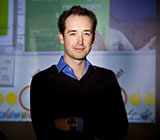 You really find the cutting edge of research at a medical conference; reading a paper is greatly enhanced by having a chance to discuss it with the researchers who wrote it at a poster session. Yet, patients desperate to see progress in their field are frequently excluded from meetings. [1] In 2015, I helped draft the #PatientsIncluded charter, but how hard is it to put into practice?
You really find the cutting edge of research at a medical conference; reading a paper is greatly enhanced by having a chance to discuss it with the researchers who wrote it at a poster session. Yet, patients desperate to see progress in their field are frequently excluded from meetings. [1] In 2015, I helped draft the #PatientsIncluded charter, but how hard is it to put into practice?
In 2017, a group of ALS/MND advocates sought to inject patient participation into the International Symposium on ALS/MND, where 1,200 clinicians, scientists, and healthcare professionals come together annually for three days. While patients have never explicitly been excluded from the conference, they were not invited either. Conference organizers have historically felt this was a meeting for researchers and that sharing content freely might hurt attendance figures and create financial risk for the Motor Neurone Disease Association that organizes it. Consequently, the latest highly awaited trial results are not webcast and may even be banned by symposium presenters from sharing on social media.
Relying on the generosity of private donors, our committee of patients, caregivers, and advocates awarded six “fellowships” to patients and their caregivers to attend the symposium. Over 20 applications were received. They were blind-rated for scientific interests, ability to disseminate information learnt at the conference, and likelihood of benefit to them and the patient community. After collating the results we contacted the fellows to let them know they’d been accepted. We sought to avoid common issues that patients have expressed, such as feeling confused or isolated at conferences by arranging webinars to make introductions, answer questions, and discuss hopes and fears for the meeting. [2]
Patient fellows and caregivers at the symposium commented that the dedication of researchers and diversity of approaches was itself inspiring. We hope that the increased visibility of patients attending sessions and promoting their findings online encouraged speakers to consider their perspective as individuals and not just abstract data points. Fellow and medical writer Sue Pondrom blogged about the use of cannabis for symptom relief, reporting on a survey of 500 patients’ experience of efficacy and side effects. Another fellow, Stephen Finger, viewed health issues through his lens as an economics professor and posed questions on long-term ventilation as a more efficient use of resources than more expensive drugs of modest impact. He also blogged on biases he observed in the placebo arms of many trials.
Sadly, several fellows had to withdraw at short notice due to the progression of their disease; a “standby list” could have helped ensure participation. Unexpected blizzard conditions in Boston and subsequent flight delays presented substantive challenges to people with mobility problems. While accommodation and registration was covered, fellows had to meet the costs of their own flights which may have exerted selection bias. For people with speech problems, there was very limited opportunity to interact directly with scientists, say by taking questions over Twitter. Caregivers were essential for most fellows, whether family, paid carers, or both.
A survey by conference organizers found 10 positive mentions of patients attending, and just a single negative comment, with one presenter worrying about having to pitch their content so broadly. Some professional attendees confided they felt inhibited talking about sensitive issues such as end of life discussions with patients present. Perhaps acknowledging such discomfort might lead to more considerate dialogue. Some pharmaceutical companies in other diseases have bristled that patients might see information designed for healthcare professionals or report adverse events—but these issues seem surmountable. In this first year we improved attendance, in future we aspire to participation and perhaps one day even co-production.
As patients, as caregivers, as advocates, we feel the tangible benefits to patients outweigh the “what if” risks. Before ALS we were CEOs, medical writers, journalists, graphic designers, pharmacists, data analysts, and educators—couldn’t a diversity of minds better tackle the problems of ALS? If they’re not at the table we’ll never know. There may be 1,200 expert researchers out there but we have the potential to harness 400,000 expert patients, not to mention their caregivers. They are hungry to help.
See also:
Acknowledgements: We are grateful to the Motor Neurone Disease Association for sharing a summary of their survey findings. A complete list of the ALS/MND patient fellows is available here.
Paul Wicks is vice president of innovation at PatientsLikeMe.
Competing interests: Paul Wicks works for PatientsLikeMe, a commercial company that encourages voluntary data-sharing from patients and provides data and services to the pharmaceutical industry. He receives research funding from pharmaceutical companies. For full details, see his page on the Patient Panel group.
References:
1 Chu LF, Utengen A, Kadry B, et al. ‘Nothing about us without us’—patient partnership in medical conferences. BMJ : British Medical Journal 2016;354:i3883.
2 de Wit MPT, Koelewijn-van Loon MS, Collins S, et al. “If i wasn“t this robust”: patients” expectations and experiences at the Outcome Measures in Rheumatology Conference 2010. Patient 2013;6:179–87. doi:10.1007/s40271-013-0017-0
